If you like me grew up in an IBM household in the early to mid-’80s, we probably share the same fond memories of some of the first games that were available for the new IBM PC and later its compatibles.
My dad had worked for IBM in the ’60s and when the first IBM PC became available in August of 1981, he bought one, and not just the base model, no he tricked it out with dual floppy drives (the base model came with no floppy drives). My brother and I still have the computer, which now has outlived our dad.
Most of the games we played back then were either pirated or available in a non-commercial fashion (shareware), the system in its first year only had a few commercial game titles available. In this article, we’ll be looking at a few of Orion Software’s titles and of course the IBM PC itself.
In a time before the term PC would be recognizable with the home microcomputer, companies like Apple, Atari, Texas Instrument, Tandy RadioShack and Commodore would all fight for their system to be the computer of choice in people’s home. Going to the local computer store was like going back to the wild west, you’d never know what system would be ending its life tomorrow and which systems would prevail. Spending hundreds if not thousands of dollars on a system with an uncertain future was not for the faint of hearted.
Typically it would be the enthusiast and hobbyist that would be spending their hard-earned bucks and not your average non-computer literate. This would all begin to change in 1981 when Big Blue, IBM, launched its first personal desktop computer, the IBM model 5150, also known as the IBM PC. While IBM had produced mainframes for decades, systems that typically would cost millions of dollars and require multiple of technicians to run and operate, it was becoming increasingly clear that the future of computing was in the microcomputer market, and with computers operated by non-technicians. Even though IBM was one of the largest companies in the world they really couldn’t overlook the fact that the microcomputer market in 1979 hit sales up worth $150 million, a figure predicted only to substantially increase over the course of the next few years.
It might seem that IBM was already late to the party, in 1981. Other companies had already been producing home computers for a couple of years. But giant IBM wasn’t sleeping and people wanted to join in on the action, but the company was in a kind of limbo state after, IBM’s president, Watson Jr. had retired in 1971. Years went on with more or less ineffective CEO’s, and with the general notion that IBM wasn’t able to make any profit in this new market, the thought of the personal computer was drowned in bureaucracy and lack of decisive management.
This wasn’t the first time IBM was late to the party, in 1952, a year later than Remington Rand’s UNIVAC computer was available, IBM released their first commercial computer and within 5 years they had 85% of the market.
The deep pockets and massive market forces of IBM was something to be reckoned with.
In Florida, former Apollo mission system programmer, Philip Estridge, now employed at the IBM Entry Level Division, along with 12 fellow engineers, started working on a personal computer, build with off the shelves parts and components. While doing research it became evidentially clear that retailers who would be selling the IBM computer, required the computer to be serviceable by the store’s employees and not only by a select few.
The team opted for an open architecture and wanted to make the design specification publicly available, to give third-party software and hardware developers an advantage, that would make the computer and ecosystem way more attractive to the consumer.
When negotiations with Digital Research to include the CP/M operating system fell through Bill Gates of Microsoft, who IBM earlier had requested a BASIC interpreter from, acted swiftly and purchased the right to QDOS for $50.000. QDOS was quickly reworked to fit IBM’s needs and rebranded as PC-DOS. Gates, clever as he was, guessed that IBM’s open architecture would spawn other manufactures copying IBM’s design and then would be in need of an operating system, made a non-exclusive deal with IBM, giving him the opportunity to license his operating system to IBM’s upcoming rivals, MS-DOS was born.
The IBM PC, released in August of 1981, would become IBM’s most profitable computer, and even though the base price was in line with the Apple II, to be really useful it had to be upgraded, costing at least double that (around $9.000 in 2019 money).
Nonetheless the IBM PC was the best personal computer when released and with the clever and $36 million expensive marketing campaign, that went into it (Charlie Chaplin’s The Little Tramp character) solidified the term PC as a name everybody would recognize with an IBM Personal computer or compatible running Microsoft DOS – even though the term PC really covers all personal computers no matter the architecture. Unlike today, back in those days there were heaps of different architectures, today we in reality only have a few – and these are typically not defined by architecture but by operating System.
As with IBM in the ’50s, it wouldn’t take long before it dominated the market. IBM had $4 billion in annual PC revenue by 1984, more than twice that of Apple and over 50% of all American companies that used microcomputers were using an IBM PC.
IBM’s open architecture and non-exclusive rights to the operating systems ultimately had fatal consequences for the future of the IBM PC. Initially, it was great for the system but in the long run not very healthy for the company. In the coming years, hundreds of manufacturers would produce IBM compatibles, that not only would be cheaper but also faster – The clone war was in full effect.
The originally IBM PC and PC-DOS weren’t targeted for games, but like with most other computer systems before, it ended up being a significant driving force.
IBM included Microsoft Adventure, as the only game in the initial software release for the original IBM PC, I have earlier done a much more comprehensive article of Adventure, which can be seen here.


IBM had Microsoft Adventure as a launch title for the IBM PC, in the coming months and years they would publish titles developed in-house and by third-party developers.
The first of these were all released in typical corporate IBM fashion, in pretty dull and unattractive packaging
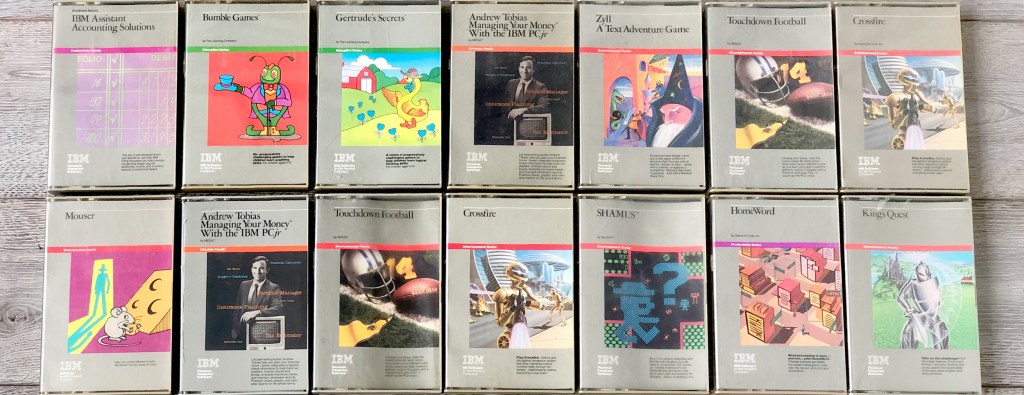
IBM would later on release software titles in plastic cases, here both for the IBM PC and IBM PCJr. IBM ended up only publishing game titles in the early to mid- ’80s and then again for a period of time in the latter part of the ’90s
Besides software titles published by either IBM or Microsoft, not many commercial titles where available the first year. Orion Software was one of the very first publisher to commercially release games for the new platform.
Orion Software
One of the very first commercial publishers of games for the new IBM PC was Orion Software, Inc. out of Auburn, Alabama.
Orion Software was founded in 1980 by Kevin Azzouz while he still was in college. The company would focus on entertainment software for the Apple II and IBM personal computers. In its four year lifespan, Orion would only release a handful of titles – The company was acquired in 1984 by California based Paperback Software, started by Adam Osbourne, the creator of the first successful portable computer, with the notion of bringing software to bookstores at a cheap price (just like paperback books).
Paratrooper, released in 1982, was based upon On-Line Systems title, Sabotage, developed by Mark Allen and released for the Apple II in 1981.
On-Line System’s Sabotage, created by Mark Allen and released for the Apple II in 1981 became the basis for Kuperberg’s first game, Paratrooper
Paratrooper like most of the early games was in 4-color CGA and with PC-speaker sound and “music”. It was released as a PC-Booter meaning it didn’t need an operating system to run – You just pop the disk in and boot it up.
Paratrooper, Kuperberg’s first title, published by Orion Software in 1982. Paratrooper, while a clone, inspired quite a few games itself, games often referred to as Paratrooper like games
Paratrooper was developed by math genius Greg Kuperberg when he was just 15 years old. Kuperberg would end up programming three games for the IBM PC before he enrolled at Harvard University in 1983 – All of his titles were written in assembly language and ran silky smooth on the 4.77 MHz Intel 8088 CPU – and all titles were published by Orion Software and sold either in computer stores or as mail-order.
While Paratrooper was a clone, the title would go on and spawn many clones itself. Paratroopers was later released in the Master Blaster IBM compilation series from Keypunch – Paratrooper was only released for the IBM PC.
PC-MAN, a non-licensed and non-discrete clone of Namco’s 1980 hit Pac-Man, also created by Kuperberg and released in 1982. I’m guessing that back in the early ’80s copyright infringements weren’t really a thing – It seems everybody copied everything and would look good and make money while doing it.
Kuperberg removed the “a” in Pac and it became PC-Man, what a great and striking title, no resemblance to Pac-Man now, oh wait the artwork taking up the whole front of the package looks 100% like Pac-Man. Ah screw it, at least now the IBM PC owners had a chance to play this great coin-up game.
PC-Man from 1982, probably the best Pac-Man clone for the IBM/PC. It was initially, like Paratrooper, released in a Ziplock bag (left) but was rerelease later in a plastic case, just like J-Bird (right)
J-Bird, supposedly Orion’s best-selling game, was released in 1983, this was Kuperberg’s last game before he went on to University. J-Bird was a Q*Bert clone, and quite a good one. Kuperberg was great at making the most of the limited hardware available at the time. J-Bird’s isometric view looks great and gives a feeling of real 3D, it is probably one of the first, if not the first, isometric game for the IBM PC. Like with PC-Man, the J-Bird name was only a few letters away from the original it copied.
J-Bird, a Q*Bert clone, published by Orion Software in 1983. J-Bird became Kuperberg’s last game before going to University
All of Orion Software’s titles are extremely rare today, and finding any information on them proved nearly impossible. Nonetheless, these games, and especially Paratrooper were a really important part of the early history of the IBM PC.
In later articles, I’ll be looking at some of the other prominent titles from the early days of IBM PC gaming.


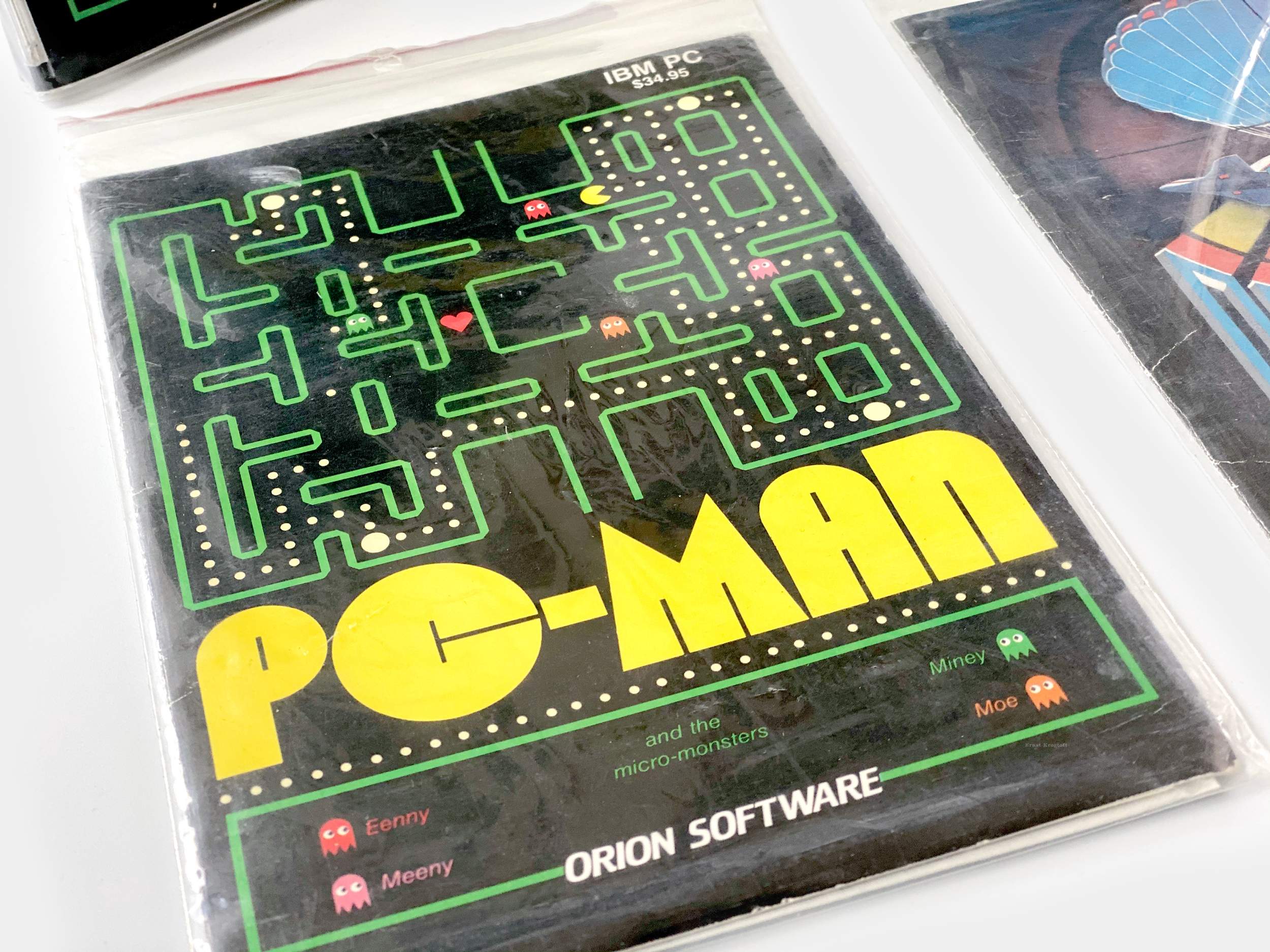
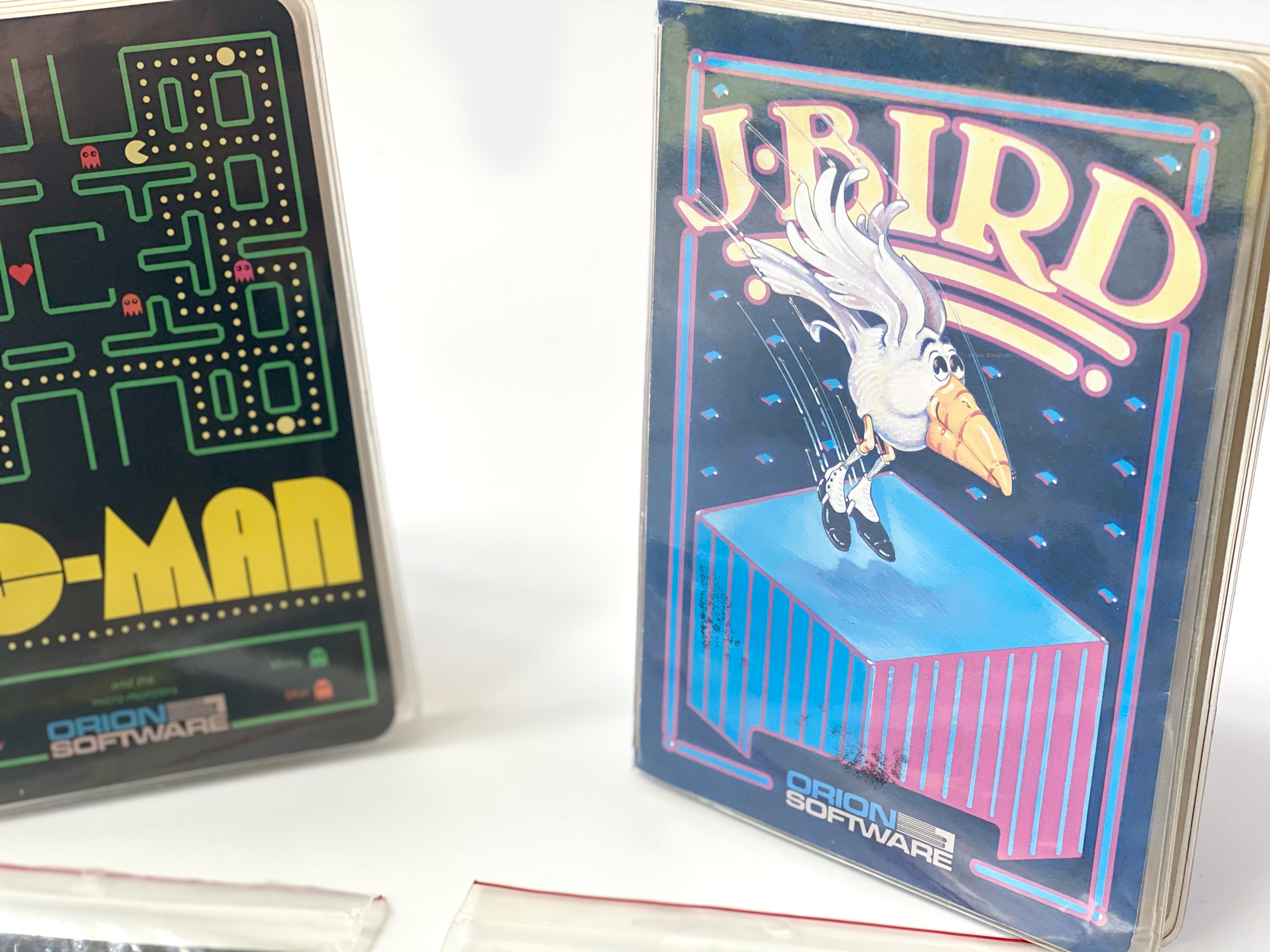




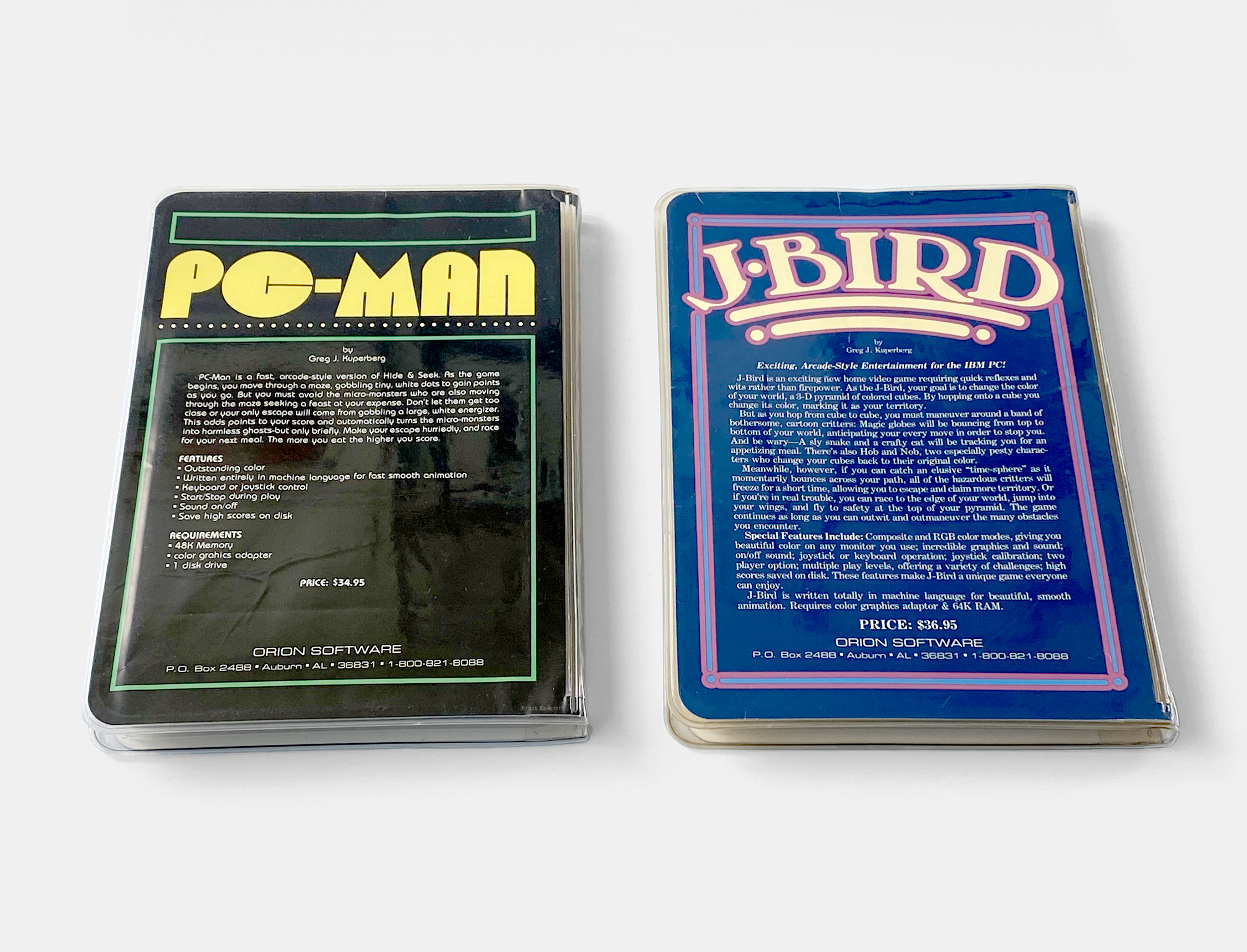

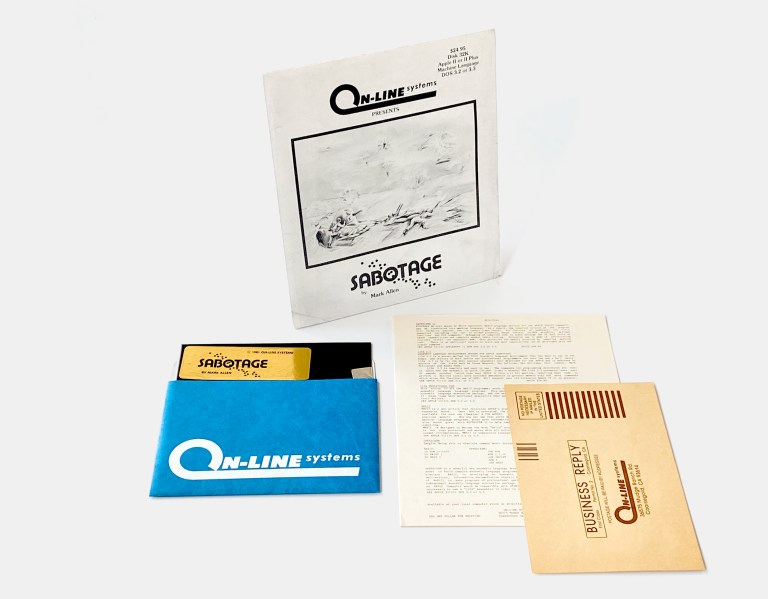
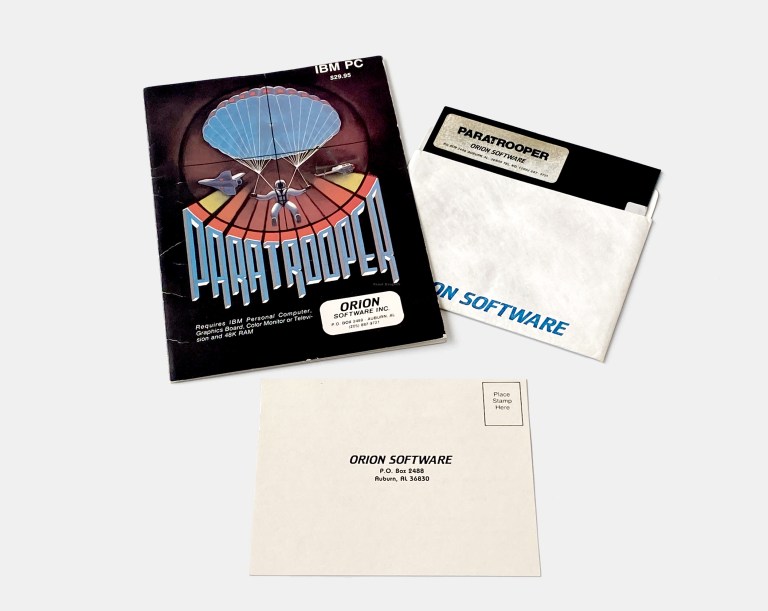


Nice collection!
I also have aobut 2000+ kinds of IBM 5.25″ games.
But I want to fix the following games due to be modified.
IBM Strategy Games.
Paratrooper
PC-MAN
This can be fixed by Teledisk dumped image.
I also have original J-Bird with 2-3 original disks.
Thanks:) do you have a website for your collection or somewhere else I can enjoy it.
I’m not sure what you mean by, you want to fix the listed games.
Are you interested in selling a J-Bird disk?
Best
Ernst
Been doing some research for the J.Bird game buy orion software, but is extremely hard to find much, how much do you think this game could be worth?
Any chance you can make some cover scans from those Orion games, in particular Paratrooper and J-Bird, and post them online?
Mobygames has cover scans for PC-MAN, but lacks the other two.
From the IBM games, it seems cover scans are also missing for Gertrude’s Secrets.
Hi Robert, sorry for the late answer. Please contact me on Twitter or Facebook.